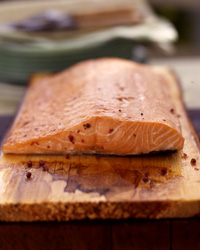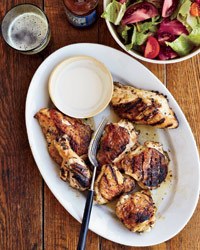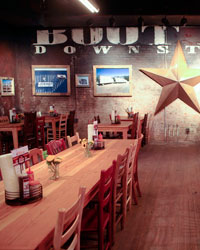 Hill Country chef and barbecue/grilling expert Elizabeth Karmel. Photo courtesy of Cramer-Krasselt.
Hill Country chef and barbecue/grilling expert Elizabeth Karmel. Photo courtesy of Cramer-Krasselt. Whether it’s a tip on testing a gas connection or knowing when your brisket’s done, few know more about cooking over flames than Elizabeth Karmel—and fewer still can explain the hows and whys as clearly. The North Carolina native has been obsessed with fire cookery for nearly two decades. In the 2000s she brought Texas barbecue to the Northeast as the executive chef of Hill Country Barbecue and Market in New York City and Washington, DC. The author of three books on the subject also keeps a trove of information on her twin websites, elizabethkarmel.com and girlsatthegrill.com. Here she shares the differences between a rub, a mop and a sauce, plus why you should oil your food, not your grill grates.
I was living in New Orleans, and I was missing my North Carolina pulled pork. I realized that I was going to have to teach myself how to make it if I was going to have it more than a couple of times a year when I went home to visit. So I decided to give it a try in my backyard. I took a Boston butt (and I’ll tell the blasphemous truth: I put it on a gas grill with some wood chips) and basically let it cook using indirect heat until the whole outside was covered with beautiful rendered fat that looked like cracklins. The outside was crunchy, and inside the meat was so tender, all you had to do was use two forks to pull it—into pulled pork! Then I made the Lexington-style dip, a.k.a. the vinegar barbecue sauce, which I grew up with. I made that by taste memory, too. I loved what I tasted, and I fed a whole houseful of hungry folks who proclaimed it just as good as any pulled pork they’d had in North Carolina. That was the beginning of my barbecue love story.
Barbecue is a culture and a lifestyle, it’s not just about the food—it is an authentic community. Even at competitions, which are very competitive, everyone is family. If you run out of something or forget a spice or a tool, your neighbor will loan it to you if they have it. Nobody’s trying to sabotage anyone—or if they do, they don’t stay in the community for very long.
And I have never seen anything in my life that melts the demographics the way barbecue does. It doesn’t matter who your daddy is, what your educational level is—if you like barbecue and the other person likes barbecue, you’re fast friends. It’s a genuine community in this complicated world.
In this country, we refer to grilling as “hot and quick” cooking and barbecue as “low and slow” cooking. That’s actually the subtitle of my first book, Taming the Flame: Secrets for Hot-and-Quick Grilling and Low-and-Slow BBQ, because it is easy to understand. But the real difference is that authentic barbecue is only cooked with indirect heat (no heat directly underneath the food), often for long periods—and it has to involve wood. I often say that real barbecue is seasoned by time and wood smoke. That wood smoke is different region to region, but a kiss of natural wood smoke is what makes barbecue barbecue.
Direct heat is cooking directly over a heat source; indirect heat is cooking food by convection or hot air rotating around the food. I tell people who cook indoors that direct heat is like sautéeing or broiling, and indirect heat is like roasting or baking. The combo method is my favorite way to grill: sear over direct heat, finish over indirect. For indirect heat, if I’m cooking with coals, I’ll arrange the coals on either side of a drip pan. Some people say to pile all the coals to one side, but one side is inevitably hotter than the other, and you have to rotate the food to cook it evenly. If the heat is even, you don’t have to touch the food. With a gas grill, I turn the burners off under wherever I place the food but make sure that I light at least two burners on either side of the food. It’s all about making sure that the heat is even and consistent.
Charcoal can be either preformed briquettes or natural hardwood charcoal, which is irregular in size. The best charcoal is pure hickory hardwood char that has been formed into equal size briquettes. That’s literally hardwood that has been burned in the absence of oxygen. Charcoal was actually discovered by Henry Ford—he burned the leftover wood paneling from his cars and created charcoal.
Gas can be either liquid propane or natural gas.
Wood is hardwood—logs. Traditional barbecue uses either all wood (but not pine, because of the acrid sap) or a combination of either charcoal and wood or, today, even gas and wood.
A rub is a combination of spices—dried spices mostly, unless it’s a wet rub—that may or may not have salt in it. If you make a rub without a salt, then you need to season with a little salt just before cooking. A dry rub can be thought of as a dry marinade that adds flavor and promotes a crispy crust or bark. (One of my favorite dry rub spices is dehydrated garlic, because it imparts a pungent garlic flavor in a dry form so it won’t scorch, unlike fresh raw garlic when exposed to the heat.) Wet rubs have a thick, wet consistency and are applied much like a thick marinade.
A mop is thinner than a sauce. They’re both flavoring liquids, but a mop is a thin, savory basting sauce that’s mopped or dabbed. It doesn’t have as much sugar in it, so you can put it on much more frequently during cooking. Mops are used a lot in authentic barbecue to keep the meat moist during the long cooking time, and will add layers of flavor to the bark. One of the easiest and best mops can be made with your favorite barbecue sauce, a couple pinches of your favorite barbecue rub and a can or a bottle of beer, whatever you drink. The reason they’re called mops is because the thin sauce was traditionally mopped—literally mopped onto the food with a cotton mop. In parts of the South, they actually use a full-size cotton mop when they’re doing whole animals, to get the sauce in there. I actually created the first-ever silicone barbecue mop because I wanted to be able to wash it, and I didn’t want the fibers of the mop to stick to the food. There’s no good way to wash a cotton mop or keep it from shredding.
Barbecue sauce is a highly flavored liquid that’s brushed on the food at the end of the cooking time to add another layer of flavor. It also adds moisture, and very importantly, it gives it great visual appeal. A slather of sauce will make any piece of food glisten and glow—it brings out beautiful colors in the food.
It’s interesting because it doesn’t only take smoke to make a smoke ring. Gas, charcoal and wood all do the same thing: They emit nitrogen dioxide, which reacts with water, oxygen and proteins in the meat to turn them pink. The same reaction happens when nitrates turn cured meats pink. It even happens in home gas ovens, when a big enough piece of meat is cooked at a medium-low temperature. A lot of times when people roast their turkeys in the oven at Thanksgiving, they think that their turkey is undercooked because it’s pink close to the skin, but it’s actually a kind of smoke ring.
One of the things I love most about grilled food is that nice, dry, crispy crust that develops during cooking. In barbecue the “best bite” for me is always the bark, or burnt ends, because it’s a combination of many flavor seasonings: The rub, mop, et cetera, the meat protein and the wholly rendered-out fat that has cooked long enough to turn almost burnt.
In a blind taste test, most people can’t tell the difference. In fact, the opposite almost always happens: With their eyes closed, people think what was actaully cooked on gas was cooked on charcoal. Gas is a very clean medium, so you can really taste everything else more clearly—the smoke, the caramelization, the wood if you use wood chips (and it’s very easy to use wood chips on a gas grill). These days, almost 80 percent of Americans use a gas grill, so gas is where it’s at. Good gas grills changed the game. These grills, which often performed better than indoor ovens, brought more and more people to the backyard. More people are cooking whole meals from the grill, going way beyond classic campfire food. When I’m baking a cobbler or a pie, I prefer a gas grill to a charcoal grill, because gas heat is going to be consistent and clean. But generally I use both. I’m an equal-opportunity barbecuer—both in what I eat and what I cook on!
The great thing about natural gas is you can hook a grill up to a gas line so you never have to refill a tank. Most standard size gas grills use 20-pound propane tanks that last for 20 hours (the general rule of thumb is one pound of propane for one hour of cooking). There’s no real difference in how either one cooks, but the higher the BTUs on a gas grill, the more fuel it will use, so the 20-pound tank might not last as long as it’s meant to.
It’s very important to follow some routine steps when you’re using a gas grill. I list them all on my site. A key one to start: Check that a gas line is secure: Pour soapy water on it. If it bubbles up, that means it has a leak.
I always tell people to buy the best and the biggest grill they can afford. When people buy their first grill, they often think, “Oh, we’ll just do a few sausages and hamburgers, we don’t cook very much.” But you want a grill that will be big enough to cook a turkey for Thanksgiving, because once you learn how to grill, you’re going to use it more than your oven.
Those are kamado grills, and there are two major brands: The Big Green Egg and Primo. I love the Primo Oval XL because it has almost the same real estate as a gas grill. Some of the other kamado grills are only 18.5 inches in diameter, so it’s hard to cook lots of food or barbecue big pieces of meat.
Just make sure you get a high capacity chimney starter, so that you only need one of them. You should have about 50 total or 25 gray-ashed briquettes on each side of your kettle if you’re cooking indirectly.
They’re ready to go when there’s no longer a flame and they’re coated with a white gray ash.
All you need are wet wood chips and a metal container. You can use a smoker box, a small aluminum-foil drip pan, or you can fashion your own smoker box out of heavy-duty aluminum foil. You soak the chips in water for 30 minutes, place them in the foil or an open smoker box and set the box on the back-left corner of the grill while you’re preheating it with all burners on high. That gets the chips smoldering and smoking. Once you put the food on, reduce the heat and close the lid, the food will be infused with the great flavor of smoke.
I always travel with a silicone-coated blending fork and two pairs of 12-inch locking chef tongs. One has red duct tape on it, one has green duct tape on it. Red means stop: Raw food touched these. Green means go: Cooked food touched these. I created the “stop and go” tongs to prevent cross contamination.
I use tongs like an extension of my hand. The best are 12-inch locking chef’s tongs that don’t open more than six inches. People think the longer the tongs are the better, but the truth is the longer the tongs, the less control you have. Our wrists aren’t that strong. If the tongs splay open too much (and a lot of them open to 12 inches or more), you can get a cramp from having to hold them closed. I sell tongs, and I literally measured the distance of a hand at rest so that they wouldn’t open any more than what was comfortable if you were holding tongs for hours, like I do.

How to avoid grill “stickage,” secrets to perfect beef brisket and more essential lessons from Karmel. READ MORE »

“A lot of people marinate raw food in barbecue sauce, because they’re thinking, Oh, I want barbecued chicken,” says Karmel. The problem is that sauce often contains sugar, which burns quickly, resulting in a lackluster version of the classic dish. Here, more ways home cooks ruin great ingredients, and how to avoid those mistakes. READ MORE »

“Barbecue is like religion and politics: People are passionate about it. There are many regions, and every region thinks they are the best,” says Karmel. Here, the North Carolina native offers a mouthwatering regional barbecue guide, which explains how she became an “all-encompassing, equal-opportunity barbecue lover.” READ MORE »

No comments:
Post a Comment